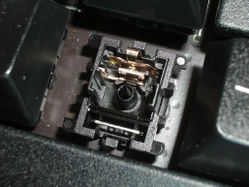Jumper
In computer keyboard terminology, a jumper or jumper wire refers to a wire soldered between two points on a printed circuit board (PCB) to assist with trace routing. The term "jumper" is used by Cherry in the specifications of the Cherry MX keyswitch despite the alternative use of "jumper" to refer to a configuration shunt.[1]
In keyboards without diodes, routing all the matrix wires in accordance with 2-key rollover is difficult. Jumper wires allow traces to "tunnel" under the PCB so that they effectively cross over other traces.
There are several approaches taken to routing traces:
- Multi-pin switches
- Switches such as Omron B3G-S series and the KPT switch have three pins, with two of them being connected by one of the contact plates; additional traces can then be run underneath the switch, with the switch functioning as a jumper wire.[2] There are also various switches with four pins.
- Integrated jumpers
- The Cherry MX series has two holes at the front of the switch, which can accommodate a jumper, a diode, or an LED; Alps SKFR/SKFS series switches also feature integrated jumpers. Alps SKFL series and Mitsumi miniature mechanical are both examples of switch designs where part of the switch itself (the metal lid) is conductive and forms a jumper.
- External jumpers
- The PCB can simply have pieces of wire soldered between traces outside of any switches. On keyboards with N-key rollover, the diodes also provide this purpose, as seen in the PCBs for the NEC PC-8201A and Zenith Supersport SX.
Jumper wire inside a Cherry MX switch (bottom of picture)
Sasse SPST "A2" with jumper partially removed; the jumper shape allows it to fit in the diode bay in the switch
References
- ↑ Cherry — CHERRY MX Series Key Switch
- ↑ KBTalking — ★★類ALPS雙藍軸二色KPT-102機械鍵盤★★



